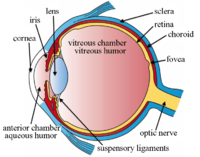
Photo from wikipedia
Background: The aim of this study was to analyze demographically stratified incidence rates of patients with diabetic macular edema (DME) commenced in anti-VEGF therapy, to study temporal trends, to report… Click to show full abstract
Background: The aim of this study was to analyze demographically stratified incidence rates of patients with diabetic macular edema (DME) commenced in anti-VEGF therapy, to study temporal trends, to report the proportion of patients in active therapy over time, and to develop a model to forecast the future number of patients in active treatment. Methods: This was a retrospective registry-based study of all patients with DME who received at least one intravitreal anti-VEGF treatment from 1 January 2007 to 30 June 2022. Population data were extracted from Statistics Denmark. Results: This study included 2220 patients with DME who were commenced in anti-VEGF therapy. Demographic analyses revealed higher incidence rates among males than females and among those aged 60–80 years. The number of patients in active treatment followed an exponential decay curve; hence, this was used to mathematically model the number of patients in active therapy. The number of patients in active treatment is expected to stay relatively stable with a minimal increase until the year 2023. Conclusions: This study provides insight into the practical aspects of the anti-VEGF treatment of DME that allow the planning of adequate health services.
Journal Title: Journal of Personalized Medicine
Year Published: 2023
Link to full text (if available)
Share on Social Media: Sign Up to like & get
recommendations!